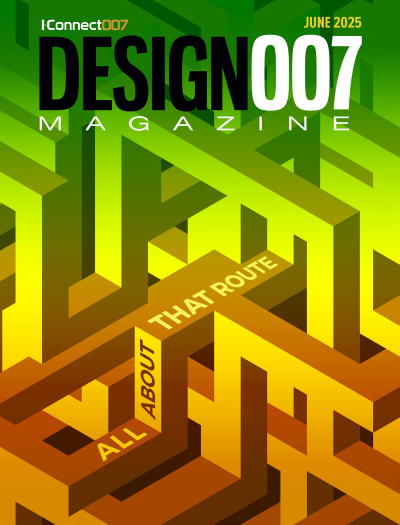-

-
News
News Highlights
- Books
Featured Books
- design007 Magazine
Latest Issues
Current Issue
All About That Route
Most designers favor manual routing, but today's interactive autorouters may be changing designers' minds by allowing users more direct control. In this issue, our expert contributors discuss a variety of manual and autorouting strategies.

Creating the Ideal Data Package
Why is it so difficult to create the ideal data package? Many of these simple errors can be alleviated by paying attention to detail—and knowing what issues to look out for. So, this month, our experts weigh in on the best practices for creating the ideal design data package for your design.

Designing Through the Noise
Our experts discuss the constantly evolving world of RF design, including the many tradeoffs, material considerations, and design tips and techniques that designers and design engineers need to know to succeed in this high-frequency realm.
- Articles
- Columns
- Links
- Media kit
||| MENU - design007 Magazine
Harnessing Knowledge: A New IPC Course Now Available
January 27, 2025 | Nolan Johnson, I-Connect007Estimated reading time: 3 minutes
Didem Üstün is a mechanical engineer and subject matter expert about military cable design who’s now teaching a wire harness and semiconductor course through IPC. Here, she and Kel Allen, IPCs online instructor-led training manager, discuss the mechanics of the course and why you should consider taking it—especially if you have limited knowledge of wire harness.
Nolan Johnson: Didem, tell me about the work you do.
Didem Üstün: I hold a bachelor’s degree in mechanical engineering from Gazi University. I have just graduated from the Executive MBA program at Bilkent University in Ankara. I have been working at a defense company in Turkey for more than 10 years. Right now, I have been working at FNSS Defense Systems for almost nine years.
I am preparing and presenting harness subsystem design and integration plans according to project requirements. I am also both preparing cable design/manufacturing documents and data packages, which include electrical wiring schematics, 2D/3D drawings and identifying specific requirements linked to the associated cables in accordance with IPC/WHMA-A-620 standards and auditing subcontractor companies to ensure that their cable manufacturing complies with standards.
Johnson: Let’s talk about the new IPC course. What does it cover?
Üstün: This course provides a comprehensive foundation of wire harness and cable design for the electronics industry. We will cover a range of basic cable and wire types and other fundamental components and materials. This program also talks about wire harness. Students will understand and learn how to read the electrical wiring diagram for their wire harness and how they need to develop their design according to this diagram. These fundamental things are critical issues for wire harness design.
Johnson: We don’t often think about how the disciplines of semiconductor and wire harness course intersect or how they interface. Who should be attending this course?
Üstün: This course is fundamental for wire harness design, but is also designed for mechanical engineers, electronics engineers, designers, and operators.
Johnson: Engineers seem obvious, but why should operators also take this course?
Üstün: If operators understand the technical and design drawings, they can provide more accurate feedback to the engineers during manufacturing. That's why it's important. It's really good for them to take this course.
Johnson: Oh, I see. If the operators understand the fundamentals better, then they can interact with the engineers about issues much more knowledgeably.
Üstün: Exactly.
Johnson: With engineers and operators attending the class together, I anticipate they will all learn a wide range of new skills. What are some of the skills that you would expect the attendees to take away?
Üstün: After this course, participants will easily apply what they’ve learned to their jobs because knowing the fundamentals of wire harness will help them start to design. They will learn about the important elements for design and how to plan for manufacturing withing their design skills. These skills will enable them to more effectively design a reliable cable solution.
Kel Allen: Can you elaborate on that more? What will students know how to do?
Üstün: Students will understand how to read the electrical wiring diagram so that they can properly design a wire harness design, thinking about how to choose the right materials for their cable design. That is the basic foundation for my cable design. That's why it's really important to understand these steps.
Johnson: What else should we know about the class?
Üstün: It is an online, ongoing course that meets twice a week in two-hour sessions. Our first, two-week session begins Feb. 3, 2025 with convenient times for North America and European students. We will offer it two additional times this year: June and September.
Allen: Similar to our PCB design classes, where students build a project through the use of Altium using a license we provide, this course focuses the steps of wire harness design by examining wire applications, electrical schematics and evaluating industry standards like IPC/WHMA-A-620, which students receive a copy as a resource for the course.
IPC is expanding its training courses beyond traditional PCB design to engage more of our members by providing information that expands into nontraditional areas. Enroll to secure your place in IPC’s Introduction to Wire Harness Design I. For more information and to enroll, visit our course page.
Johnson: Thank you, Didem and Kel, for explaining more about the class. Sounds very interesting.
Suggested Items
DownStream Acquisition Fits Siemens’ ‘Left-Shift’ Model
06/26/2025 | Andy Shaughnessy, I-Connect007I recently spoke to DownStream Technologies founder Joe Clark about the company’s acquisition by Siemens. We were later joined by A.J. Incorvaia, Siemens’ senior VP of electronic board systems. Joe discussed how he, Rick Almeida, and Ken Tepper launched the company in the months after 9/11 and how the acquisition came about. A.J. provides some background on the acquisition and explains why the companies’ tools are complementary.
Elementary Mr. Watson: Retro Routers vs. Modern Boards—The Silent Struggle on Your Screen
06/26/2025 | John Watson -- Column: Elementary, Mr. WatsonThere's a story about a young woman preparing a holiday ham. Before putting it in the pan, she cuts off the ends. When asked why, she shrugs and says, "That's how my mom always did it." She asks her mother, who gives the same answer. Eventually, the question reaches Grandma, who laughs and says, "Oh, I only cut the ends off because my pan was too small." This story is a powerful analogy for how many PCB designers approach routing today.
Connect the Dots: The Future of PCB Design and Manufacturing
07/02/2025 | Matt Stevenson -- Column: Connect the DotsFor some time, I have been discussing the increasing complexity of PCBs and how designers can address the constantly evolving design requirements associated with them. My book, "The Printed Circuit Designer’s Guide to… Designing for Reality," details best practices for creating manufacturable boards in a modern production environment.
Siemens Turbocharges Semiconductor and PCB Design Portfolio with Generative and Agentic AI
06/24/2025 | SiemensAt the 2025 Design Automation Conference, Siemens Digital Industries Software today unveiled its AI-enhanced toolset for the EDA design flow.
Cadence AI Autorouter May Transform the Landscape
06/19/2025 | Andy Shaughnessy, Design007 MagazinePatrick Davis, product management director with Cadence Design Systems, discusses advancements in autorouting technology, including AI. He emphasizes a holistic approach that enhances placement and power distribution before routing. He points out that younger engineers seem more likely to embrace autorouting, while the veteran designers are still wary of giving up too much control. Will AI help autorouters finally gain industry-wide acceptance?


